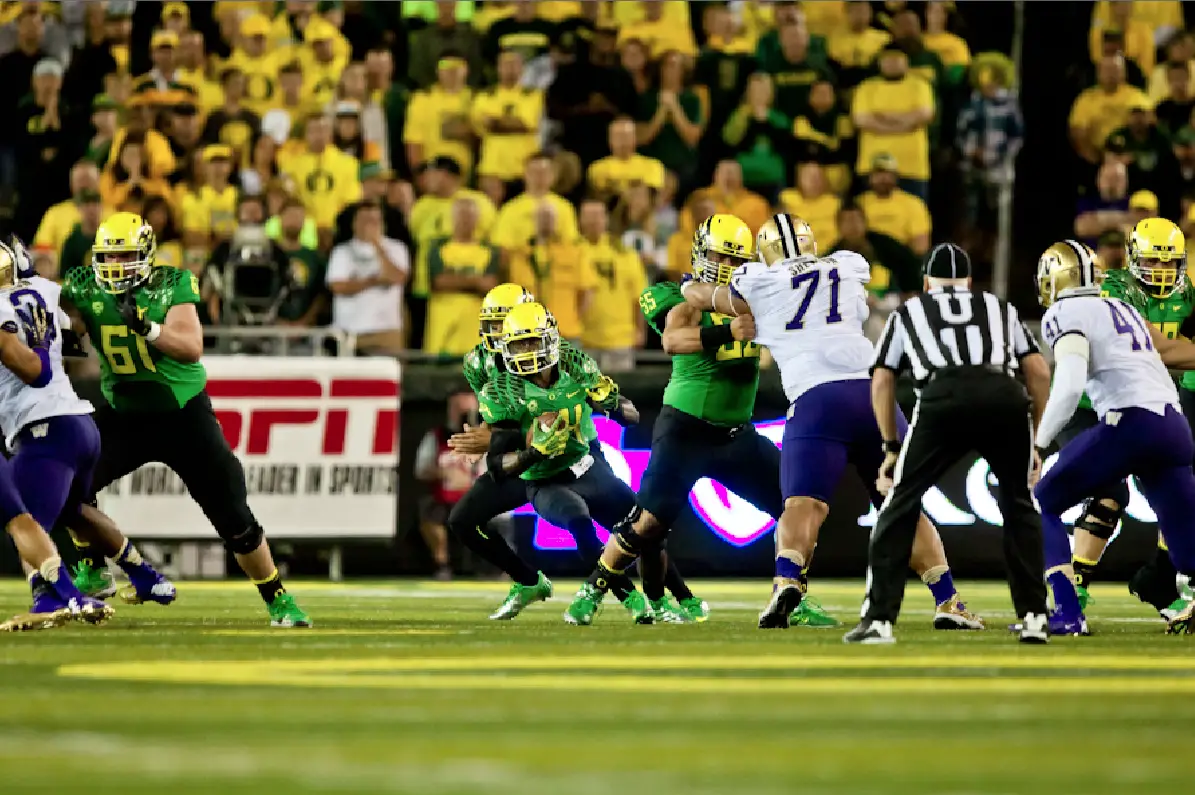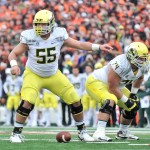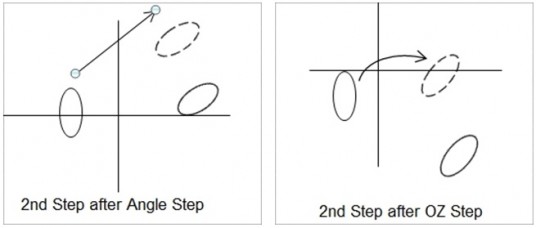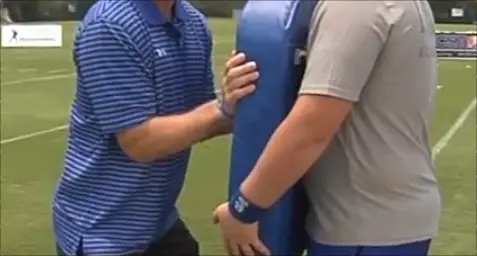When watching the Oregon Ducks execute their high octane run game it is easy to get caught up in the play-making ability of their skill players. Watching guys like Marcus Mariota and De’Anthony Thomas is exhilarating. What some fail to realize is the success or failure of the run game hinges on the offense’s ability to control the line of scrimmage (LOS). This portion of the field is patrolled by the big guys up front and it is their ability to execute blocking techniques and schemes that allow Thomas to rip off his electrifying, and often unbelievable, jaunts into the end zone. As such, it is vital for these players have the skills necessary to pave the way for ball carriers to display their talents.
The heart of Chip Kelly’s explosive spread offense is the zone scheme and it is vastly different than the traditional man- blocking schemes of offenses used by some other teams. When blocking the inside and outside zone schemes, linemen are responsible for areas, or gaps, rather than specific players. This concept is uniquely suited to what Coach Kelly is trying to accomplish when he spreads the field horizontally with his formations.
Zone Scheme Basics
The foundational plays of any zone scheme are the Inside Zone (IZ) and Outside Zone (OZ). While similar, the variance in the schemes presents a unique look to the defense and stresses the defensive front in different ways. Both are sound against defensive blitz and stunt schemes and put a lot of pressure on defensive pursuit.
Inside Zone
 The IZ is an inside run play predicated on multiple double teams and a vertical push at the LOS. Each lineman will take a six inch angle-step to their play side gap and will read the defenders in front of them, blocking the man who attacks their gap. If no one shows, the lineman continues on his track and looks to the backside for flowing defenders. The ball carrier presses the LOS of scrimmage, usually with an aiming point at the play side guard’s outside hip. As the back presses, he is looking for a crease in the defense. When it opens up, he attacks the hole. The result, if the ball carrier is patient and has good field vision, is often a large running lane and huge cutback behind over-pursing defenders.
The IZ is an inside run play predicated on multiple double teams and a vertical push at the LOS. Each lineman will take a six inch angle-step to their play side gap and will read the defenders in front of them, blocking the man who attacks their gap. If no one shows, the lineman continues on his track and looks to the backside for flowing defenders. The ball carrier presses the LOS of scrimmage, usually with an aiming point at the play side guard’s outside hip. As the back presses, he is looking for a crease in the defense. When it opens up, he attacks the hole. The result, if the ball carrier is patient and has good field vision, is often a large running lane and huge cutback behind over-pursing defenders.
Outside Zone
 The OZ is an outside run play predicated on reaching the defender in your play-side gap and stretching the defensive front horizontally. This is why it is sometimes referred to as the zone stretch. When the OZ is called, the offensive lineman will take either an outside zone step or a “bucket step” in order to gain the leverage and proper angles necessary to get to the outside shoulder of the defender they are going to block. Once again, they block anyone that attacks their assigned gap and if no one shows they continue on their track and look to the backside for flowing defenders. The ball carrier again presses the LOS, this time with an aiming point at the outside hip of the edge blocker. This is usually the tight end or play side tackle; but might also be a slot receiver or other player depending on the offensive formation. Once again, he looks for a running lane and attacks any lane that opens up in the defensive front.
The OZ is an outside run play predicated on reaching the defender in your play-side gap and stretching the defensive front horizontally. This is why it is sometimes referred to as the zone stretch. When the OZ is called, the offensive lineman will take either an outside zone step or a “bucket step” in order to gain the leverage and proper angles necessary to get to the outside shoulder of the defender they are going to block. Once again, they block anyone that attacks their assigned gap and if no one shows they continue on their track and look to the backside for flowing defenders. The ball carrier again presses the LOS, this time with an aiming point at the outside hip of the edge blocker. This is usually the tight end or play side tackle; but might also be a slot receiver or other player depending on the offensive formation. Once again, he looks for a running lane and attacks any lane that opens up in the defensive front.
Key Characteristics for the Zone Scheme Offensive Lineman
When developing an offensive line for the zone scheme, the coach is looking for a unique set of skills. The ideal lineman in the zone scheme does not need to be the biggest or strongest player on the field. It is far more important for him to be athletic and intelligent with great field vision and an ability to execute a specific set of techniques. The following attributes are essential for a dominant zone scheme blocker.
- Flexibility – To execute the blocking scheme and maximize effectiveness, the offensive lineman needs to have a certain degree of
 flexibility in his ankles, knees, and hips. This will allow him to be more comfortable in the appropriate stance and will benefit him in his ability to move quickly with an optimal pad level.
flexibility in his ankles, knees, and hips. This will allow him to be more comfortable in the appropriate stance and will benefit him in his ability to move quickly with an optimal pad level. - Stability – The offensive lineman must be able to move his feet quickly in his footwork without stumbling or falling down. This includes keeping a wide base and an ability to redirect the feet numerous times once the play has started.
- Footwork – The techniques involved in the zone scheme are heavily dependent on the proper steps necessary to ensure effective blocking angles and establishing favorable leverage on the defender. This requires attention to detail and thousands of repetitions. It also requires a certain level of agility and quickness.
- Field Vision – Linemen must develop an ability to see the defensive front and the reactions of defenders after the ball is snapped. They must have the ability to use their vision to track the defender and use leverage to cut off his path to the ball carrier.
- Football IQ – Linemen must have the intelligence to execute the play read the defense’s reactions. Zone scheme offensive linemen must also learn how to set up the play with their alignment and technique. This requires an understanding of the defensive concepts they will face and the concept of the called play.
- Physicality – This is a general requirement of all offensive linemen. The nature of the position requires the athlete to be capable of moving people around and is heavily predicated on attitude. He needs to attack defenders relentlessly with a goal of imposing his
 will. Coach Kelly likens this to the mentality of a bouncer and wants his offensive linemen to have the tenacity and desire to handle the defender as if “throwing him out” of his zone or gap. This gets the point across as to how physical he wants his linemen to be.
will. Coach Kelly likens this to the mentality of a bouncer and wants his offensive linemen to have the tenacity and desire to handle the defender as if “throwing him out” of his zone or gap. This gets the point across as to how physical he wants his linemen to be.
Developing these characteristics is a matter of implementing a variety of drills in a daily routine and setting a high level of expectation in the tempo and attitude brought to their daily execution. The athlete must establish a desire to not only execute the techniques, but to do it with intensity and attitude. He must make a decision to own his zone and protect it with every fiber of his being.
Becoming a Better Zone Scheme Lineman
Developing skills as a lineman requires learning progression that starts with athleticism. As stated previously, the zone lineman needs to have flexibility, balance, and good feet. The following drills will aid the athlete in improving these aspects of his skill set and will build a foundation upon which his effectiveness on the field will improve.
Lower Extremity Flexibility
Before the zone scheme offensive lineman even steps on the field it is vital for him to have a certain level of hip, knee, and ankle flexibility. A common issue with offensive linemen is stiffness and lack of mobility in the lower extremities. They can half-squat a bulldozer, but have difficulty moving their joints through their full range of motion. This presents problems with many techniques in the zone scheme and needs to be addressed off-season, as well as during the season.
A great resource for flexibility and mobility is Kelly Starrett’s MobilityWOD.com. Starrett is a doctor of Physical Therapy and his site is dedicated to ensuring mobility and flexibility. I recommend frequenting his site and watching the video below.
Flexibility Exercises
Improving Agility and Stability
Along with flexibility it is important for the zone scheme offensive lineman to train his body for stability, balance, and agility. Improving these characteristics directly correlate to better performance on the field and also should be addressed both in and out of season. Implementing the following movements in a routinely will help the athlete build the stability, balance, and agility necessary to execute the footwork and athletic movements demanded by zone scheme coaches. Explore the videos below for some great training tools.
Warming Up & Agility Bags
This video goes through some dynamic warm up activities that focus on flexibility and balance. It is a great way to start your workout. After the dynamic warm-up, the video moves on to demonstrate some agility bag drills that are a fantastic way to improve general agility, balance, and quickness.
Ropes
Rope drills (below) are another great way to improve general agility, balance, and quickness.
Agility Ladder
The agility ladder (below) is one of my favorite drills for the zone scheme offensive lineman. It is extremely versatile and really improves the athlete’s foot speed and agility.
Ladder Drills
Offensive Lineman Techniques for the Zone Scheme
Now let’s explore some of the actual techniques used by the offensive lineman in the zone scheme. This is where all the flexibility, agility, and stability work done above correlate to drill work on the practice field and ultimately to execution during the game.
Stance
The beginning of every great football play starts with a great stance. It is essential for the zone scheme offensive lineman to become 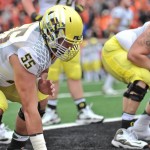 comfortable in his stance and have the ability to move in and out of it quickly and easily. To develop this, the athlete should go through a variety of Stance and Start drills on a daily basis in practice. I would also recommend including some of these things in your off-season workouts as well.
comfortable in his stance and have the ability to move in and out of it quickly and easily. To develop this, the athlete should go through a variety of Stance and Start drills on a daily basis in practice. I would also recommend including some of these things in your off-season workouts as well.
The offensive lineman’s stance in the zone scheme typically utilizes a base that puts the feet slightly wider than shoulder width apart with either foot staggered back slightly. The stagger typically correlates with the down hand and is in heel-to-toe or instep-to-toe relationship. The variance depends on the coach’s philosophy. Some coaches want their lineman to the right of the ball to put the right hand down, and those on the left side to put their left hand down. Some like a deeper stagger. Others allow the athlete to start where they are more comfortable and may even teach a balanced stance. Oregon likes to vary the stance used by their offensive front between a three-point stance and a two-point stance.
In the three-point stance, the key is balance. The athlete’s body weight should be evenly distributed between the feet and the front hand. This will help to reduce the occurrence of false stepping and allow for more stability through initial movement.
Once the feet are set the lineman will lean forward slightly, ensuring that he keeps his back flat and parallel to the ground. He will then 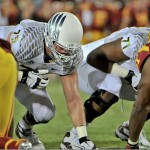 drop the appropriate hand, slightly offset from his body’s mid-line, and place on five fingers on the ground. He will shift his weight forward slightly to achieve even weight distribution at each point of contact with the ground. The lineman will keep his off-hand outside the knee in a loaded position ready to strike the opponent. He will keep his knees over his toes and in line with his hips. This helps to keep proper balance and allows for more power when exploding out on the snap of the ball. He will also keep his eyes up, maintaining an ability to see the defense and the field in front of him.
drop the appropriate hand, slightly offset from his body’s mid-line, and place on five fingers on the ground. He will shift his weight forward slightly to achieve even weight distribution at each point of contact with the ground. The lineman will keep his off-hand outside the knee in a loaded position ready to strike the opponent. He will keep his knees over his toes and in line with his hips. This helps to keep proper balance and allows for more power when exploding out on the snap of the ball. He will also keep his eyes up, maintaining an ability to see the defense and the field in front of him.
In the two-point stance, the feet will be set in the same manner; however, the lineman will keep both hands off the ground and in the  loaded position. In this stance, he will maintain a ski-slope in the back, again with his head up and his eyes on the defense. In this position he needs to ensure his chest and shoulders are held in a proud position. Again, his weight will be shifted slightly forward and he will keep his shoulders in line with his knees and ankles. In both stances he will transfer his body weight to the insteps of his feet with his heels slightly off the ground. This enables the lineman to move quickly in both directions and helps to ensure greater balance.
loaded position. In this stance, he will maintain a ski-slope in the back, again with his head up and his eyes on the defense. In this position he needs to ensure his chest and shoulders are held in a proud position. Again, his weight will be shifted slightly forward and he will keep his shoulders in line with his knees and ankles. In both stances he will transfer his body weight to the insteps of his feet with his heels slightly off the ground. This enables the lineman to move quickly in both directions and helps to ensure greater balance.
The video below provides a basic overview of the techniques for the three-point stance.
Lineman Stance Video
Zone Scheme Footwork
Executing the zone blocking scheme requires specific footwork depending on the play call and the defensive alignment. Again, the lineman should drill these techniques on a daily basis to develop a high level of proficiency in the various movements required to execute zone running plays.
Basic Steps
Zone scheme linemen need to have physical proficiency with six basic steps to gain the angles and leverage necessary for a successful zone play. The initial step is a short step; think six inches and replacing the toe with the heel.
-
-
- The Base Step – The base step is used most frequently on the IZ play and usually occurs when a lineman is covered by a down lineman in his backside side gap. It is a straight ahead step.
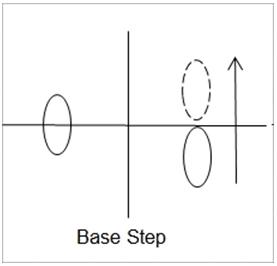
- Angle Step – The angle step is a 45 degree step used for the IZ when uncovered, covered heads up, or covered in the play side gap by a down lineman.

- Slide Step – The slide step is used for the OZ when covered in the backside gap by a down lineman.
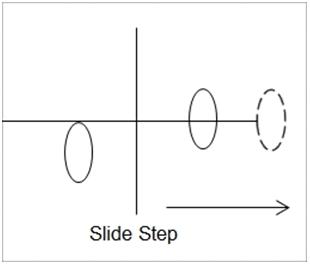
- OZ Step – The OZ Step is used when covered heads up or in the play side gap by a down lineman.
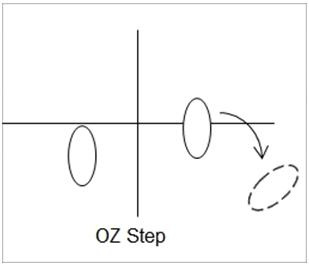
- Bucket Step – The bucket step is used on the OZ play when uncovered or the near play side defender is in a wide technique.

- The Base Step – The base step is used most frequently on the IZ play and usually occurs when a lineman is covered by a down lineman in his backside side gap. It is a straight ahead step.
-
Each of these steps establishes the angle and eventual leverage of the lineman’s attack. In the diagram below we see how the first step establishes the direction and angle of his movement and his second step continues in the same direction. His second step aiming point is through the crotch of the defender. This brings the athletes base back under him while also reestablishing the stagger. The following diagrams demonstrate where the lineman’s second step will be.
When developing as a zone scheme blocker, the first two steps need to be in the ground as quickly as possible. The quicker it happens, the more devastating the lineman’s blocks will be. The following video demonstrates an excellent drill to practice the Base Step, the Angle Step, and the OZ step.
Cone Drill for Footwork Technique
Punch Techniques
In addition to footwork, offensive linemen in a zone scheme need to develop the punch they will use when making contact with the defender. The punch phase of the offensive lineman’s technique occurs simultaneously with his footwork. As he comes out of his stance and begins to take his first step he will drive his elbows straight back and bring his hands to the bottom of his rib cage. He needs to make sure his elbows and wrists are tight to his body and his thumbs are pointing upward. The photo below illustrates the proper arm and hand placement. Note the elbows are in close to the body and the thumbs are pointing up.
More Drills to Develop the Zone Scheme Offensive Lineman
Stance and Starts
The first two steps of the offensive lineman in the zone scheme are so critical they should be practiced on a daily basis. To drill the footwork, the athlete should do a series of drills where they get into a proper stance and practice each step on air, concentrating on perfect reps. The video below shows how this can be done with boards. Notice how they progress from just taking one step, to taking two steps, and then taking both steps and finishing through the end of the board.
Stance and Start Drills
Zone Combo Hand Shield Drills
2-Man Inside Zone Read Drill Vertical Push
A great drill to teach the concepts of the IZ blocking scheme is the 2-Man Zone Read Drill. In this drill, the two offensive linemen work on their footwork and vision to gain vertical push on the down lineman and cut off the scraping linebacker. To set it up you will need four players, two offensive linemen and two defenders with hand shields. You will set the defenders up in various shades and direct them to attack different gaps. The offensive linemen will execute the IZ blocking scheme and read and react to the action of the defenders. They are trying to work the down lineman vertically with an initial double team while keeping their eyes on the linebacker.
Coaching Points
-
-
- Ensure the athletes start with the correct stance and take the proper steps.
- Ensure the athletes are using their eyes. The athlete needs to see the field. Ensure they are finding landmarks and can always see the linebacker.

- Ensure the athlete is executing the proper punch. Elbows in and thumbs up.
- Ensure the athletes are maintaining a low pad level and attacking the defenders aggressively.
- When leaving the combo to pick up a scraping backer, ensure the offensive lineman are taking a good angle to meet the defender. Often times, inexperienced players will run to where the defender is rather than where he will end up.
- Ensure the blockers stay square on the defenders and attack their middle. The idea is to cover them up and drive them backward.
- Ensure the lineman maintain the block to the whistle. Teach them to become part of the tackle.
-
2-Man Zone Read Drill
2-Man Outside Zone Read Drill No LB Horizontal Stretch
A variation of the IZ read drill is the OZ read drill. The setup is the same, but the offensive linemen are now executing their OZ footwork and working to get the outside shoulder of the defender sealed off. They will take OZ or bucket steps and run to the outside. Again, they will read and react to the defense and control their gap.
Coaching Points
-
-
- Same as above with the exception of the aiming points and movement. Ensure the lineman are working to the defenders outside shoulder and stretching them horizontally.
-
3-Man Zone Read Drill
The 2-Man Zone Read Drill can be expanded to include more linemen with the 3-Man Zone Read Drill.
More Drill Videos
Punch Drills
This drill develops the offensive lineman’s punching power and can be executed on a padded wall as shown, on bags, or on the sled.
Board Drills
Zone Cutoff Drills
2nd Level Blocking Drill
Zone Cutoff Drill
Zone Sled Drills
Zone 5-Man Sled
Zone 2-Man Sled
Conclusion
Football is a fantastic game with an unrivaled complexity. It requires a unique blend of concept development and technical proficiency that can be improved by proper training. With this article I wanted to present some of the things that can be done to develop offensive linemen to be more effective with zone scheme techniques. If the athlete engages in these drills the results will be evident when they have the opportunity to execute during practice or games.
Please keep in mind that this is not an exhaustive breakdown, and I did not fully address every desirable characteristic for the zone scheme offensive lineman. The importance of physicality and football IQ, while not extensively discussed here, are also vital aspects to the successful implementation of the zone scheme. Even if the athlete develops perfect technique he will be limited if he is does not understand the concepts of the plays and is unable to apply them aggressively. These characteristics can be developed as well, but that discussion is beyond the scope of this article.
If you would like to discuss any of the topics here in greater detail, please feel free to contact me at optionfootball [at] optionfootball.net or follow me on Twitter via @OptionFootball. Additionally, if you want to explore other aspects of the game please feel free to visit my site OptionFootball.net. I thoroughly enjoy the game of football and welcome discussion on any facet of the game. Thank you for reading and I hope you were able to get something in exchange for the time it took to go over this material.
I may be in New York, but…”oh how we love to learn about your beloved Ducks!”
Levi Steier
Oregon Football Analyst for FishDuck.com
Albany, New York
Top Photo from Craig Strobeck
Levi Steier, (Football Analyst) after a collegiate playing career cut short by injuries, began his coaching career as a student assistant at Dakota State University. Since then he has coached primarily at the high school level. During this time he has been a head coach and has coordinated all three phases of the game. He is currently the owner of a web design business and the publisher at OptionFootball.net where he discusses many aspects of football, but regularly focuses on option oriented football topics. Coach Steier enjoys talking football and encourages anyone who would like to discuss the game or find more information to visit his site. You can follow Levi on twitter @OptionFootball, on his Facebook page and on Google+.

